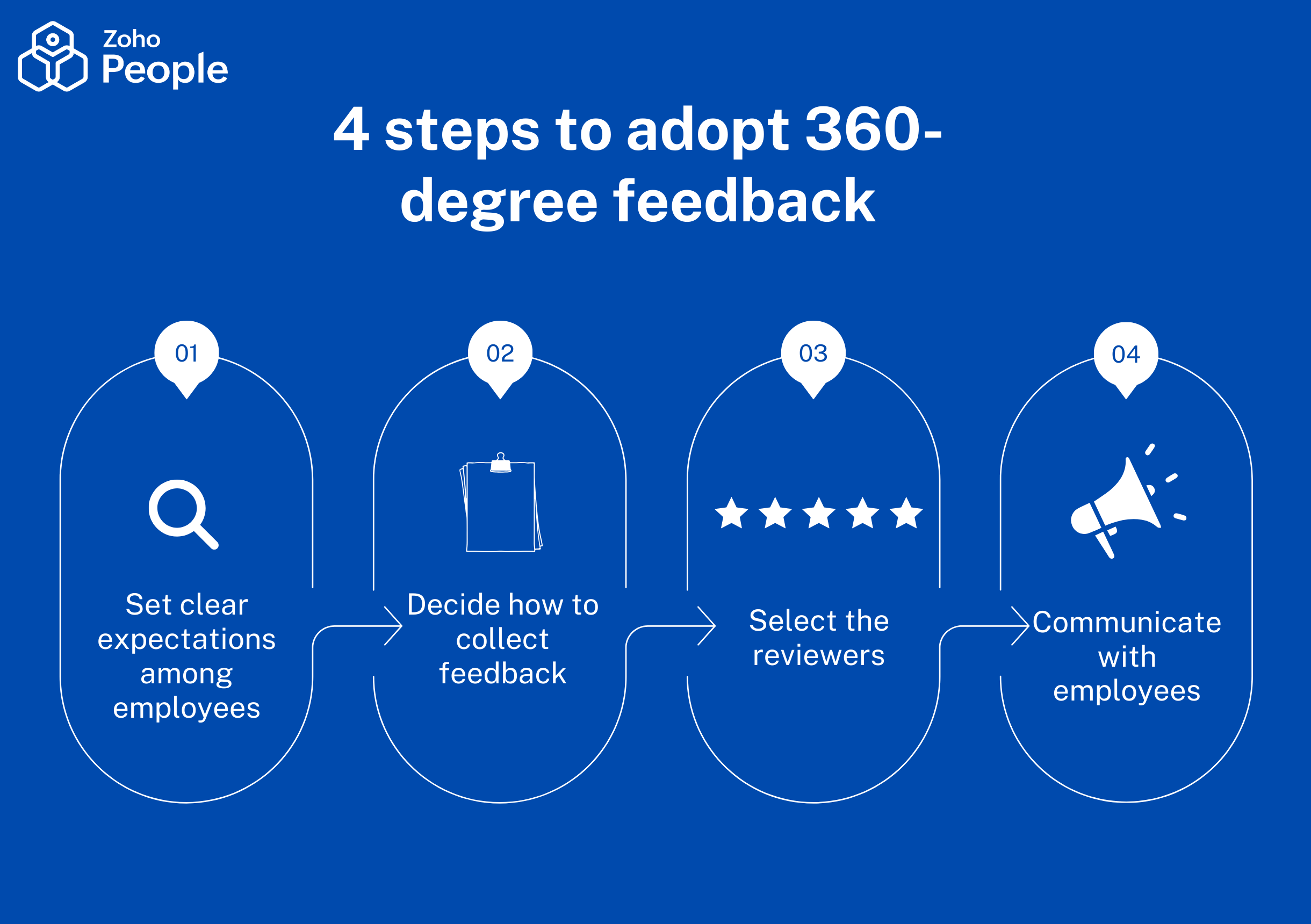- HOME
- More
- On Zoho People
- 360-degree feedback system: Everything you need to know
360-degree feedback system: Everything you need to know
- Last Updated : March 13, 2024
- 3.7K Views
- 6 Min Read

As more and more employees focus on their career development, organizations are adopting the 360-degree feedback system to run more meaningful performance reviews. But, what is 360-degree feedback? How does it work, and will it suit every organization? Let's get into the basics of this comprehensive approach to employee feedback.
What is the 360-degree feedback system?
360-degree performance feedback, also referred to as multi-rater feedback, is an aspect of the appraisal process that enables employees to receive feedback from the people they work with. Usually, employees are rated by their peers, managers, and their subordinates.
For instance, say you lead the HR team at your organization and want to evaluate the performance of one of your recruiters. Let's assume that this particular recruiter worked with the marketing lead to hire for the marketing team. To provide useful reviews, you could ask the marketing lead to rate the recruiter's performance and provide constructive feedback, since they've worked closely with the recruiter. If the recruiter has direct reports and you want to evaluate their managerial skills, you could ask their direct reports to provide feedback on how well the tasks were delegated and if they understood what was expected from them when tasks were assigned.
360-degree feedback surveys can be anonymous or not, depending on employee needs. Managers can then use the responses to set meaningful goals and provide relevant training programs to employees.
What are the pros of 360-degree feedback?
Here are some of the major benefits of including a 360-degree feedback as part of your appraisal cycle:
Improves performance
Receiving feedback from everybody your employees have worked with will help managers and the employees themselves get a true understanding of their strengths and weaknesses. This will, in turn, allow these employees to take better steps toward building on their strengths and overcoming their weaknesses during the upcoming performance period.
Strengthens teamwork
360-degree evaluation can strengthen teamwork and lead to better collaboration among your employees, since each of them provides constructive feedback to facilitate the career development of their colleagues. This develops a culture of trust and continuous development.
Reduces implicit bias
When managers receive feedback about employee performance from different sources, they're better able to make fair performance decisions. This also makes managers well-aware of every aspect of employee performance, fostering a culture of transparency and openness.
Keeps employees satisfied
Adopting a 360-degree appraisal tool for your organization shows your interest in helping employees progress in their careers without any bias. Since growth never stagnates, employees will feel satisfied and engaged.
What are the cons of 360-degree feedback?
One of the major disadvantages associated with 360-degree evaluation is that, if an employee and their reviewer are not on good terms, the reviewer may end up focusing on the employee's negatives rather than on providing constructive feedback. Another issue is that some reviewers may not have enough time, and they may fill out the surveys just for the sake of it, rather than thoroughly considering the employee's performance.
How to implement 360-degree feedback for your organization

If you are planning on adopting 360-degree evaluation for your organization, here are four tips to keep in mind to get the best out of your new system:
1. Set clear expectations
Before you even start the process, get a clear idea of what you wish to achieve with it. In most cases, this system is implemented to help employees become more aware of their performance and speed up career development. As you begin defining your system, you'll want to determine which behaviors you want to evaluate. Once you are clear on this, make your employees aware of how this new approach to feedback is going to help each one of them. Elaborate on what they'll be evaluated on and help reviewers understand which performance aspects to consider before providing feedback.
2. Decide how to collect feedback
Once you help your employees understand what is expected from them, get a clear idea of how you are going to facilitate the process. You'll want to decide on the type of questions you are going to ask the raters when it comes to evaluating different competencies. For instance, if you are evaluating an employee's communication skills, your questions can focus on critical aspects of communication including listening skills, empathy, open-mindedness, respect, presenting skills, and body language. Once you finalize the questions, determine how to collect responses from reviewers. Keep in mind that most performance management systems come with a built-in tool that enables you to collect feedback as part of the appraisal process; this way, the data is centralized in a single system.
3. Select the reviewers
It's critical to select the right set of people so that you get the useful insights required to improve employee performance. It's important that the reviewers have worked for a decent amount of time with the employee under review and have a fair working relationship with them. You'll want to verify that the relationship is ongoing or based on a recent collaboration, rather than based on interactions that reach too far back. Select a minimum of eight reviewers so that you can get a full picture of employee performance without any biased perspectives. Be sure to provide ample amount of time to reviewers so that they don't have to provide ratings and feedback in a hurry.
4. Communicate with employees
Once you've received all the feedback, encourage managers to draw insights and communicate their findings with employees as part of the appraisal process. Encourage your managers to also talk about how employees can develop their strengths and manage any performance blind spots. If possible, ask them to create a development plan with goals and KRAs for the upcoming performance period. Remind them to solicit feedback from the employees under review, too.
What are some examples of 360-degree feedback?
360-degree feedback example for managers
"You've been doing a great job providing a better sense of direction to all our team members while motivating them to bring their best to work. You also make it a point to stay approachable, set clear expectations, offer constructive feedback, and take input from the team."
360-degree feedback example for peers
"As my co-worker, you are always available to collaborate and offer useful insights during our brainstorming sessions. You've also shown your willingness to support fellow team members whenever needed. One area to improve would be task prioritization to better meet your deadlines."
360-degree feedback for subordinates
"I want to appreciate your dedication to meeting tight deadlines while ensuring quality projects. However, I do feel that there's room for improvement when it comes to how you communicate with your peers and clients. Let's work on it together."
360-degree feedback system: Frequently asked questions
How does the 360-degree feedback system work?
In a 360-degree feedback system, a handful of peers with whom the employee has worked are chosen to offer their insights and perspectives about that employee's performance. This helps managers provide more objective reviews.
How do you complete 360-degree feedback?
As a first step in 360-degree feedback, the performance reviewer identifies all colleagues, team leads, and managers that an employee has worked with during the performance period. Next, the reviewer uses a 360-degree feedback tool to create a survey with questions that focus on the employee's role, responsibilities, competencies, and behaviors. Then, they send the survey out to coworkers. The performance reviewer then analyzes the results to provide performance feedback to the employee being evaluated.
What does 360-degree feedback measure?
A 360-degree evaluation system uses coworker insights to measure how effectively an employee carries out their responsibilities. It measures behaviors and competencies that are critical for their role (such as leadership skills, team work, customer focus, and creativity).
How often should 360-degree feedback be conducted?
It's ideal to conduct 360-degree feedback surveys once every three months. This ensures that employees have a clear idea about their professional strengths and weaknesses and know which areas of their performance to work on.
Adopting 360-degree feedback
360-degree feedback is a powerful tool that can help your employees move up in their careers. However, its success largely depends on how well you implement it at your organization. We hope this blog post gave you a clear idea of the benefits and processes involved in the 360-degree feedback system.
Zoho People's performance management system comes with a robust 360-degree feedback module to help performance administrators provide unbiased and useful reviews to their employees. Multi-raters can be selected from the system itself.
 Tarika
TarikaContent Specialist at Zoho People


